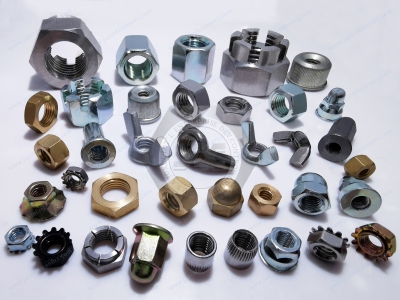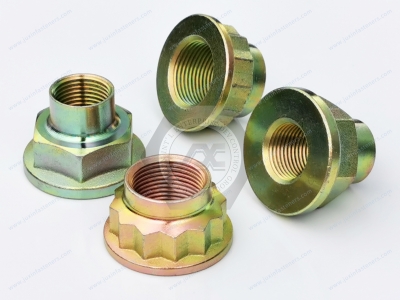Call Us
+86 136 6007 9809
Call Us
+86 136 6007 9809
Jan. 10, 2024
Guidelines for the installation and use of locking nuts
What is the meaning of lock nut?
The lock nut is widely used in machinery and other industries, and its working principle is to use the friction between the nut and the bolt for self-locking. However, the reliability of this self-locking will be reduced in the dynamic load. On some critical occasions, we will take some anti-loosening measures to ensure the reliability of the nut locking. The working principle of the nut is to use the friction between the nut and the bolt for self-locking. However, the reliability of this self-locking is reduced under dynamic loads. On some critical occasions, we will take some anti-loosening measures to ensure the reliability of the nut locking. The lock nut is one of the anti-loosening measures. The lock nut locking effect mainly depends on the nut and bolt interaction between the threads. There are many ways to improve the interaction force between the engaging threads, such as the structural improvement of the nut threads, nylon nut nylon roughness, surface treatment of the threads, etc.
Types of locknuts:The first type is to use two of the same nut screwed on the same bolt, in the two nuts between the additional tightening torque, so that the bolt connection is reliable.
The second type is a special anti-loosening nut, which must be used with an anti-loosening spacer. The specialized anti-loosening nut is not hexagonal but a round nut, in a nut on the circumference of 3, 4, 6, or 8 notches (depending on the size of the nut and the manufacturer's product line varies); these notches are not only tightened the tool's point of impact but also anti-loosening shims bayonet into the place.
The third is in the nut's outer surface to the inner threaded surface drilled through the threaded holes (generally 2, 90 distribution in the outer surface), used to screw into small diameter countersunk head screws; the purpose is to give the threads to exert a centripetal direction of force, to prevent the lock nut from loosening. Market sales of better quality lock nut in the inner circle of the nut inlaid with the lock nut thread consistent with the copper block, used to avoid radial top screw directly with the locked thread contact and damage to the latter. In this kind of lock nut in the rotary movement class, parts of the shaft end of the locking occasions gradually began to apply, such as the ball screw mounting end of the bearings of the anti-loosening.
The fourth type of lock nut is composed of two parts, and each part has staggered cams; due to the internal wedge design, the slope angle is greater than the angle of the bolt's nut; this combination will be a tight bite into a whole when there is a vibration, the anti-loosening nut raised part of the mutual staggered, resulting in the lifting of the tension, to achieve the perfect effect of anti-loosening.
The fifth is the structure of the anti-loosening, through the thread structure on the design improvement, without the help of other external factors and getting a locking function. Hence, its applicability to the above methods is broad, and the environmental requirements are relatively low. Loose nuts include many different types of nuts, such as nylon nuts; there is also a flange nut; in short, this kind of loose nut plays the role of anti-loosening. Twist the nut to screws, screws, bolts, etc., can not be loosened down. So that they can be actively linked together, so that it is firm, and stability can reach a high degree.
Standard specification size
(1) Scope: This standard specifies the lock nut (referred to as nut), locking device size, technical requirements, acceptance rules, and measurement methods. It applies to the design, production, inspection, and user acceptance of nuts and locking devices for tapered bushings.
(2) The terminology used in this standard aligns with the provisions of GB/T 6930.
This standard specifies the effective moment steel hexagonal lock nut mechanical and work performance of the marking system, indicators, test methods, and signs. This standard applies to the carbon steel or alloy steel manufactured by the opposite side of the width in line with the provisions of GB 3104, nominal height ≥ 0.8D, the need to specify the guaranteed load and adequate torque, the thread diameter of 3 ~ 39mm coarse teeth 6H grade nuts. In addition to the practical torque part, its thread size and tolerance are according to GB 193, GB 196, and GB 197. The working temperature range of the nut should be in line with all-metal nuts without plating: -50 ℃ ~ +300 ℃.
Plated all-metal nuts: -50 ℃ ~ +230 ℃; embedded in non-metallic components of the nut: -50 ℃ ~ +120 ℃. This standard does not apply to nuts with special performance requirements (such as welding performance and corrosion resistance). By mutual agreement, stainless steel, non-ferrous metals, carbon steel, or alloy steel manufacturing fine teeth lock nuts or thin nuts can be used in this standard specified by the adequate torque of the performance indicators and test methods.


Influencing factors
Various factors affect locknuts' maximum unscrewing torque. To study the low-cycle fatigue performance of lock nuts, the thread diameter, helix rise angle, and tooth type bevel angle are kept unchanged; only the maximum elastic restoring force of the threaded piece FN max and equivalent friction angle ρe will show a certain degree of change after repeated use. Therefore, only these two aspects of the lock nut bear the cycle load when the maximum wringing out torque rule of change is analyzed.
1. Material strain hardening: material in cyclic loading, there will be "cyclic strain hardening" or "cyclic strain softening" phenomenon; that is, in the case of equal amplitude cyclic strain, the stress amplitude will be increased with the increase in the number of cycles and the phenomenon of increasing or decreasing. After several cycles, the stress amplitude enters a cyclic steady state. Low-cycle fatigue of locknuts is carried out when the strain is constant, and the strain hardening or softening of the threaded piece will affect the magnitude of its maximum unscrewing torque. Alloy steel used in the manufacture of locknuts belongs to the cyclic strain hardening material, hardening of the material will make the threaded piece of elastic restoring force FN increase, and the screwing out torque rises.
2. Low cycle fatigue: low cycle fatigue refers to the fatigue stress close to or over the yield limit of the material, the material has a certain amount of plastic deformation in each strain cycle, the life expectancy is generally in the range of 102 to a few multiplied by 104, the fatigue curve is usually expressed in ε-N curve. Finite element calculation results show that after the bolt is screwed into the lock nut, the stress in the root of the threaded piece is more significant. Part of the surface area is in the yield state, while the strain in the center area of the root of the threaded piece is minimal, and the strain situation is more complicated. The region with higher strain at the root of the threaded piece undergoes reciprocating loading. It is prone to low circumferential fatigue, which reduces the pressure on the threaded piece and decreases the screwing-out torque.
3. Friction coefficient: the friction angle is an essential factor affecting the unscrewing torque, and the existence of friction is the basis for the regular operation of the lock nut. Lock nut work, the contact surface in the threaded piece of elastic recovery force under the action of pressure and friction, in the process of repeated use, the contact surface in the cycle of repeated friction, the rough position and angle is smoothed and become smooth, the friction coefficient becomes smaller, which reduces the maximum unscrewing torque of the nut.
4. Manufacturing and assembly: due to manufacturing technology limitations and precision and other reasons, the thread edge there is a sharp angle or the size of the parts with the coordination is not coordinated, in the initial assembly, screwed into the screwing torque may appear a certain degree of ups and downs or fluctuations, you need to go through a certain number of times of wear and tear to get more accurate reuse characteristics of the lock nut.
5. Closing value: material and nut geometry parameters are determined, and the closing value of the change in the reuse characteristics of the lock nut has a significant impact. The closeout value becomes more extensive, the deformation of the threaded piece increases when it opens, the strain of the threaded piece increases, the strain cycle hardening phenomenon intensifies, and the pressure of the threaded piece FN becomes more extensive, which has a tendency to increase the unscrewing torque; on the other hand, the width of the threaded piece decreases, the total area of the threaded piece decreases, the friction with the bolt decreases, the strain of the threaded piece increases, and the low fatigue performance decreases, which tends to reduce the maximum unscrewing torque. In various factors, the maximum unscrewing torque with the number of repeated uses of the change is difficult to predict; only through the test can we observe it.
A lock nut is a commonly used fixed connection component; the correct installation and use to ensure the reliability of the connection to the critical importance.
Installation points and guidelines for the use of locknuts:
1. ensure the nut and threaded hole are clean and undamaged before installing the lock nut. Remove any dirt and impurities in the threaded hole to ensure the locknut can be installed smoothly. At the same time, check the match between the nut and the threaded hole to ensure that the nut can be inserted and rotated correctly.
2. When installing locknuts, attention must be paid to the correct torque and direction of rotation. According to the equipment and connection requirements, determine the appropriate torque value and use a torque wrench for installation. Too high or too low a torque may result in an unsatisfactory connection, so installation instructions and recommended torque ranges should be carefully observed.
3. When using locknuts, it is necessary to avoid thread damage due to over-tensioning. Over-tensioning may damage the bolt or threaded hole and affect the reliability of the connection. Therefore, in the process of use, the tightening force of the nut needs to be adjusted moderately according to the actual needs and installation instructions to ensure the stability and security of the connection. During routine maintenance, check the status and tightening force of the lock nut regularly. Check the nuts for looseness or deformation to ensure the stability of the connection. Periodically review and adjust the torque of the locking nut to adapt to changes and loosening of the connection. Special attention needs to be paid to the regular replacement of locknuts according to the conditions and requirements of use to ensure the reliability and security of the connection.
In short, the correct installation and use of the lock nut are critical to ensure the reliability of the connection. In the installation process, pay attention to cleanliness and matching, and reasonably select the torque and direction of rotation. In use and maintenance, regularly check and adjust the status and torque of the nut to avoid connection failure caused by loosening or over-tensioning. Correct installation and use of locknuts can ensure a solid and reliable connection and improve the efficiency and security of equipment and structures.
If you are looking for high-quality nuts fasteners or technical support for structural design, you are welcome to contact me. Thanks.Email:adelajonly@gmail.com
Website: https://www.juxinfasteners.com
Contact Us
Tel.:
+86 020 8621 0320
+86 020 3121 6067
Technical Support:
Navigation
SEND INQUIREY